Discover mobility and land transport in three historic halls
Deutsches Museum – Verkehrszentrum: transport museum
From horse-drawn carriages to steam locomotives and historic trams to e-bikes: the Transport Museum of the Deutsches Museum offers a unique exhibition on the history and present of transport and mobility.
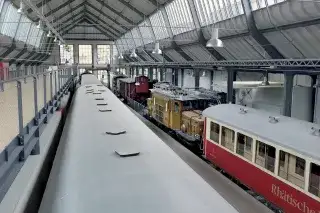
More actions
In cooperation with the cultural department and the museums
This article about Munich's museums is sponsored by the Cultural Department of the City of Munich and was conceived in cooperation with the State Agency for Non-State Museums in Bavaria. The content was coordinated between the participating museums and muenchen.de, the official city portal.
Why the Verkehrszentrum is worth a visit:
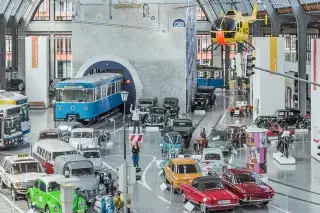
Welcome aboard! The unique exhibition invites you to experience the history of vehicles and mobility yourself – from the whistling sound of the steam locomotive to the car of the future.
What to see? The transport museum is the perfect destination for the whole family: there are many demonstrations every day. There is also an inventor's trail and a separate children's area with a long tube slide. Carriages, vintage cars, steam locomotives & co. are on and along a specially built platform, with a steam locomotive and carriage simulator that can be demonstrated.
What's special? You can discover important exhibits such as the first Benz motor car, the Rumpler Tropfenwagen, the steam locomotive "Puffing Billy" or the BMW world record motorcycle from 1935.
New magnetic train: test a revolutionary technology

At the end of Hall 1, you can float over a piece of magnetic track – and check out a revolutionary technology: Physicists Georg Bednorz and Karl Alexander Müller won the Nobel Prize in 1987 for their discovery of high-temperature superconductivity, which is used to run the magnetic train.
Technically speeds up to 600 km/h are possible with it. During the demonstrations at the Verkehrszentrum however, the train travels at a very low pace as it only wants to demonstrate the operating principle. Just a slight push from the service staff and you will glide gently back and forth. You can feel it hovering – no rolling resistance, no bumps in the road.
Verkehrszentrum transport museum: All information at a glance
- Location: Theresienhöhe (old exhibition grounds)
- Museum category: Traffic, technology
- Recommended duration of stay: Approx. 2 hours
- Children's program: Special exhibitions, children's area with slide, children's birthday parties, treasure hunt
- Directions: U4/U5 or bus 53 to Schwanthalerhöhe, bus 134 to Theresienhöhe
- Parking: Theresienwiese parking lot or Heimeranstraße parking garage
- Website: www.deutsches-museum.de/en/verkehrszentrum
Exhibition highlights: The history, present and future of mobility
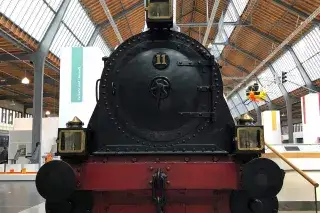
On 12,000 square meters, everything is dedicated to urban transport, travel and mobility on land. There are about 275 historic locomotives, cars, motorcycles, bicycles and carriages to discover.
The permanent exhibition is divided into three different halls:
- Hall I - "Urban Transport" takes you back to the time around 1900 on a reconstructed street. Streetcars, buses and vehicles that were built by the million in the post-war years, such as the VW Beetle, are lined up next to each other. The exhibition focuses on inner-city transportation systems, traffic structures and safety.
- In Hall II - "Travel", visitors can trace the history of means of transport – from carriage rides to express trains and coaches. The highlight: a reconstructed platform with authentic locomotives and wagons.
- Hall III - "Mobility and Technology" is dedicated to the many technical tools that people have created to make travelling easier and faster. Especially the 19th and 20th centuries were full of innovations in the vehicle sector: from the first car with a gasoline engine to the first electric train.
Free guided tours and demonstrations
- In each hall, you can join a free tour every day (11 a.m.: "Mobility and Technology," 1:30 p.m.: "Urban Transportation," 2 p.m.: "Travel").
- How about driving a suburban train by yourself? Give it a try with the free S-Bahn simulator. In addition, there is a carriage ride simulator and a model railway demonstration.
- The museum offers an audio guide with 68 tour stops.
- Feel free to join the "Thursday lectures" in Hall III (every week starting at 6:30 p.m.)
Children's area and children's program
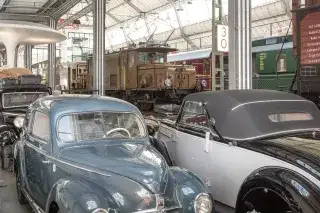
Especially for children and families, there is a lot to discover at Verkehrszentrum:
- The children's area in Hall III offers a huge space to play, paint and build things. The highlight is the tube slide.
- The free guided tours offer many exciting stories about traffic -– also for children.
- With a special treasure hunt program children can explore the transport museum themselves.
- Celebrate your birthday among steam engines and cars? That's also possible!
Food and snacks
- There is no restaurant in the Verkehrszentrum, but you will find some café tables and vending machines for drinks and snacks in Hall I and Hall III.
Tickets
- Adults: 8 Euros
- Children under 6 years: free
- Children and teenagers (6 to 17 years): 5 Euro
- Pupils, trainees and students: 5 Euro
- Seniors and people with disabilities: 5 Euro
- Family ticket: 15 Euro (two adults with their own children up to 17 years)
Digital offers
Bettina Gundler, head of the Verkehrszentrum, takes you on a virtual tour of Hall III. Thanks to 360° technology, you can have look around in all directions:
Accessibility and offers for individuals with disabilities
95% of the Verkehrszentrum's exhibition area is barrier-free. Only the staircase areas are unfortunately not accessible for wheelchairs
- Special guided tours: A special guided tour in sign language can be booked in advance.
History of the museum
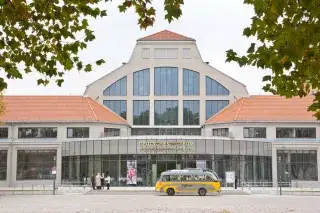
The three historic trade fair halls were designed by Wilhelm Bertsch in 1907 and opened their doors one year later. They represent an important part in the social and economic history of the city.
After the Munich Trade Fair had moved out, the Deutsches Museum restored the buildings. Hall III, the first part of the transport museum, was opened in 2003. Three years later, Hall I and Hall II followed. Since 2011, the newly constructed entrance area with offices, a small lecture hall, a visitor foyer, a cash desk and a store completed the museum.
At a glance
Deutsches Museum - Verkehrszentrum EN
Am Bavariapark 5
80339
München
Tel:
+49892179333
